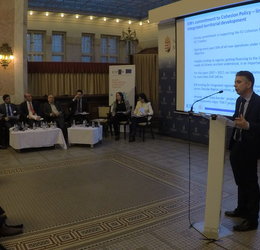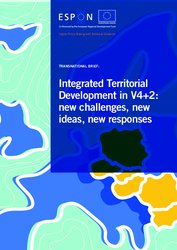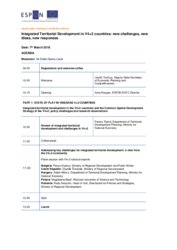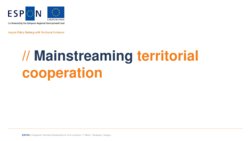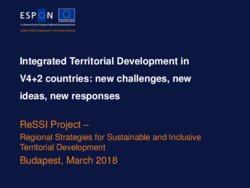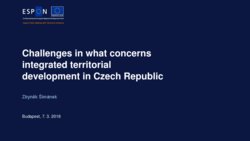Integrated Territorial Development in V4+2
Venue
Budapest, Hungary
Grand Hall of the Ministry for National Economy
1051 Budapest
Hungary
Integrated Territorial Development in V4+2 countries: new challenges, new ideas, new responses
The Visegrad V4+2 countries (Czech Republic, Hungary, Poland and Slovakia, Bulgaria and Romania) are confronted with many common challenges when it comes to integrated territorial development. When compared to the EU context, the figures indicate a different socio-economic context, with shared socio-economic, environmental, technological and planning challenges across the V4+2.
Hungary pointed out the economic and social disparities between the capital city and peripheral/rural areas as a major issue causing labour market tensions. Bulgaria highlighted the need for a new planning culture including better communication and stakeholder engagement, liked to the administrative reform. Czech Republic pointed out to the challenge of coordinating a large number of small municipalities, and the need to encourage the sustainability of the ITI for the future and for future territorial collaboration, due to the positive results being achieved. For Poland, the challenges have been to reduce sectorise into nine sectoral strategies that are sensitive to the territorial dimension and how to develop long-term socio-economic planning and spatial planning both at the regional and the local level. Romania pointed the insufficient cross-sectoral cooperation, diverging perspectives and a lack of coordination as major challenges.
Briefly, the major common challenges highlighted by the policy-makers present in the ESPON Conference were the discontinuation of development poles, axes, the lack of connectivity (transport networks), the population decline faced by some of the countries, the ‘need for a new planning culture for better coordination’ (BG) and to achieve a more balanced development. To move from a ‘sectorism’ and strategy pluralism to an integrated approach was also one of the aspects pointed out during the day (PL, RO, BG).
ESPON research also brought some advice on how to address these challenges and advises policy-makers to: (1) rethink their planning practices so as to cope with coordination challenges and globalisation trends; (2) to take on the “silo mentality” of sectoral policies and adopt a stronger holistic approach; (3) choose functional areas as the relevant level for territorial development strategies; (4) make the most of the Integrated Territorial Investments (ITI) approach and resources for metropolitan areas during the next programming period.
Furthermore, ESPON projects presented additional recommendations to policy-makers to strengthen their integrated approach. This includes breaking the prevailing downturn spiral leading to inner-peripheries; engaging in territorial cooperation for the joint provision of services of general interest; promoting and creating better conditions for the emergence of soft cooperation across territorial boundaries, sectors and stakeholders groups to tackle issues at the right territorial scale and unlocking spill-over effects of Foreign Direct Investment.
Testimonials from the policy-makers and representatives of the V4+2 countries present at the Conference highlighted some successful approaches and vision for the future:
- Integrated Territorial Investments (ITI) works: how 800 years of rivalry were overcome with ITI
- ‘Promoting metropolitan ITI for the next programming period’ (BG)
- ‘Share ESPON views that all efforts including governance, strategies and tools should be pooled together to serve functional areas’ (HU)
- ‘Improving the planning system to take into account the increasingly rapid flows of investment’ (PL)
The future of integrated territorial development rests in four main principles: (1) Territorial Integration – Strategies and governance models should be developed with territorial interdependencies in mind; (2) Cross-sectoral integration – ESPON advises to design a single development strategy rather than multiple strategies on specific subjects, thus contributing to reconcile various interests and ensuring a holistic view; (3) Partnerships – creating a favourable arena for dialogue between administrations, elected officials, NGOs, community groups and associations as well as the private sector, characterised by trust and mutual recognition of the legitimate role of the actors involved; and finally, (4) Financial integration – reinforcing the synergies between funding bodies: (a) a stronger focus on the synergies between Research and Innovation H2020 Programme and Structural Funds and increasing the links between the future FP9 programme with the Danube macro-regional objectives; (b) the INTERREG Programme – using the Danube Macro-regional strategy as a coordinating body (integrated objectives) to avoid overlaps while retaining some flexibility to deal with local contexts; (c) the European Investment Bank (EIB) – lending (loans), blending (combining funds) and advising – to develop more awareness of other funding models.
Regarding financial integration, a final round table brought representatives from INTERREG Programme, EU Strategy for the Danube Region, EU Research Programme (H2020), European Investment Bank (EIB) and ITI Instruments (DG Regio) discussing to what extent reinforcing the synergies between funding bodies can help to implement the measures pointed out above and brought some recommendation on how to be materialise. The discussion among the panellists centred on how far it was necessary to avoid overlapping projects within the V4+2 countries and it was agreed that more coordination – which also means more attention in integrating objectives across the funding bodies – is needed in the V4+2. And how the Danube macro-regional strategy could play an important role in this regard. EIB highlighted its commitment to EU Cohesion Policy, through an integrated approach – including loans, combination of EIF with EU budget and its advisory role and capacity building of national and regional partners. H2020 programme pointed out the ‘importance of synergies with ESIF and other funding programmes to maximise impact’, and particularly through the Smart Specialisation Strategies in place, but also mentioning the ‘need for a change of mindset towards a more effective and structure dialogue’ between the framework programmes and managing authorities.
In a nutshell, conclusions of the day pointed out to the following principles that must be explored in more depth: Governance – developing a more place-based focus; Competences – seeking more clarity between the V4+2 countries on where and at which levels decisions are taken; Implementation – speeding up implementation at all levels; Monitoring – keeping track of implementation and using information to adjust and fine-tune strategies; Impact – identifying and communicating impact to a wider group of stakeholders; Collaboration – developing strong networks both within and between countries and regions.



